中国沙漠 ›› 2025, Vol. 45 ›› Issue (1): 215-228.DOI: 10.7522/j.issn.1000-694X.2024.00156
• • 上一篇
收稿日期:2024-10-08
修回日期:2024-11-18
出版日期:2025-01-20
发布日期:2025-01-13
通讯作者:
张洁
作者简介:张洁(E-mail: Zhang-j@lzu.edu.cn)基金资助:
Jialiang Sun( ), Ning Huang, Yuhao Zhao, Binbin Pei, Jie Zhang(
), Ning Huang, Yuhao Zhao, Binbin Pei, Jie Zhang( )
)
Received:2024-10-08
Revised:2024-11-18
Online:2025-01-20
Published:2025-01-13
Contact:
Jie Zhang
摘要:
湍流作用下柔性植物的摆动效应会影响其防风固沙效果。基于传统多孔介质模型,开发描述植物摆动效应的动态阻力系数模型,并对植物柔韧性进行了参数化,提高了防风固沙工程设计的准确性。通过大涡模拟计算,分析不同摆动频率和幅度的植物对冠层流特征区域的影响。结果表明:柔性植物在冠层内部和近尾流区的平均速度更小,但脉动速度和湍动能更大。柔性植物周围的地表剪切应力更小,在尾流区有较好的庇护效果。高柔韧性植物在冠层顶部形成乱流区,在背风侧近尾流区产生强阵风,会降低该区域的防护效果。
中图分类号:
孙嘉梁, 黄宁, 赵昱豪, 裴斌斌, 张洁. 动态阻力系数模型在沙生柔性植物模拟中的应用与验证[J]. 中国沙漠, 2025, 45(1): 215-228.
Jialiang Sun, Ning Huang, Yuhao Zhao, Binbin Pei, Jie Zhang. Application and validation of the varied porosity model in simulating sand-grown flexible plant[J]. Journal of Desert Research, 2025, 45(1): 215-228.

图1 植物模型参数和计算域边界条件(A),以及柔性方柱阵列流固耦合(FSI,B)示意图
Fig.1 Schematic diagram of plant model parameters and boundary conditions of computational domain (A), and numerical simulation scheme for FSI using a cylinder array as the plant (B)
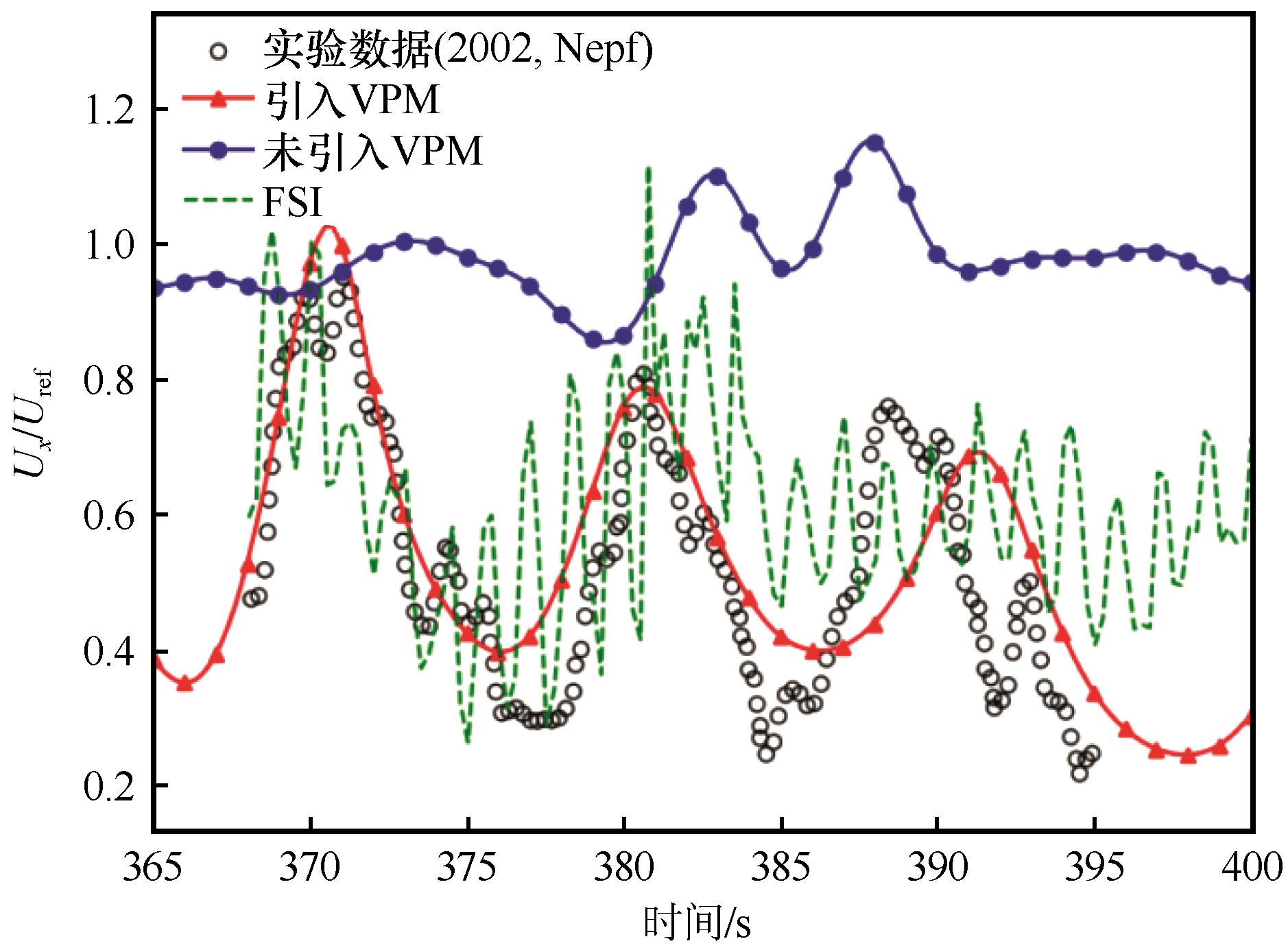
图3 不同模型植物内部瞬态速度随时间变化曲线
Fig.3 Transient velocity variation curves within the canopy layer over time, with numerical calculation results incorporating flexible plant sway compared to previous experimental data
| 工况 | 振幅A | 频率f | 位移L |
|---|---|---|---|
| 工况1 | 2 | 0.1 | 2 |
| 工况2 | 2 | 0.5 | 2 |
| 工况3 | 2 | 2 | 2 |
| 工况4 | 0.5 | 0.1 | 0.5 |
| 工况5 | 0.25 | 0.1 | 0.75 |
表1 不同植物柔韧性对应的波动方程参数
Table 1 Parameters for the simulation of dynamic resistance coefficients under different operating conditions
| 工况 | 振幅A | 频率f | 位移L |
|---|---|---|---|
| 工况1 | 2 | 0.1 | 2 |
| 工况2 | 2 | 0.5 | 2 |
| 工况3 | 2 | 2 | 2 |
| 工况4 | 0.5 | 0.1 | 0.5 |
| 工况5 | 0.25 | 0.1 | 0.75 |
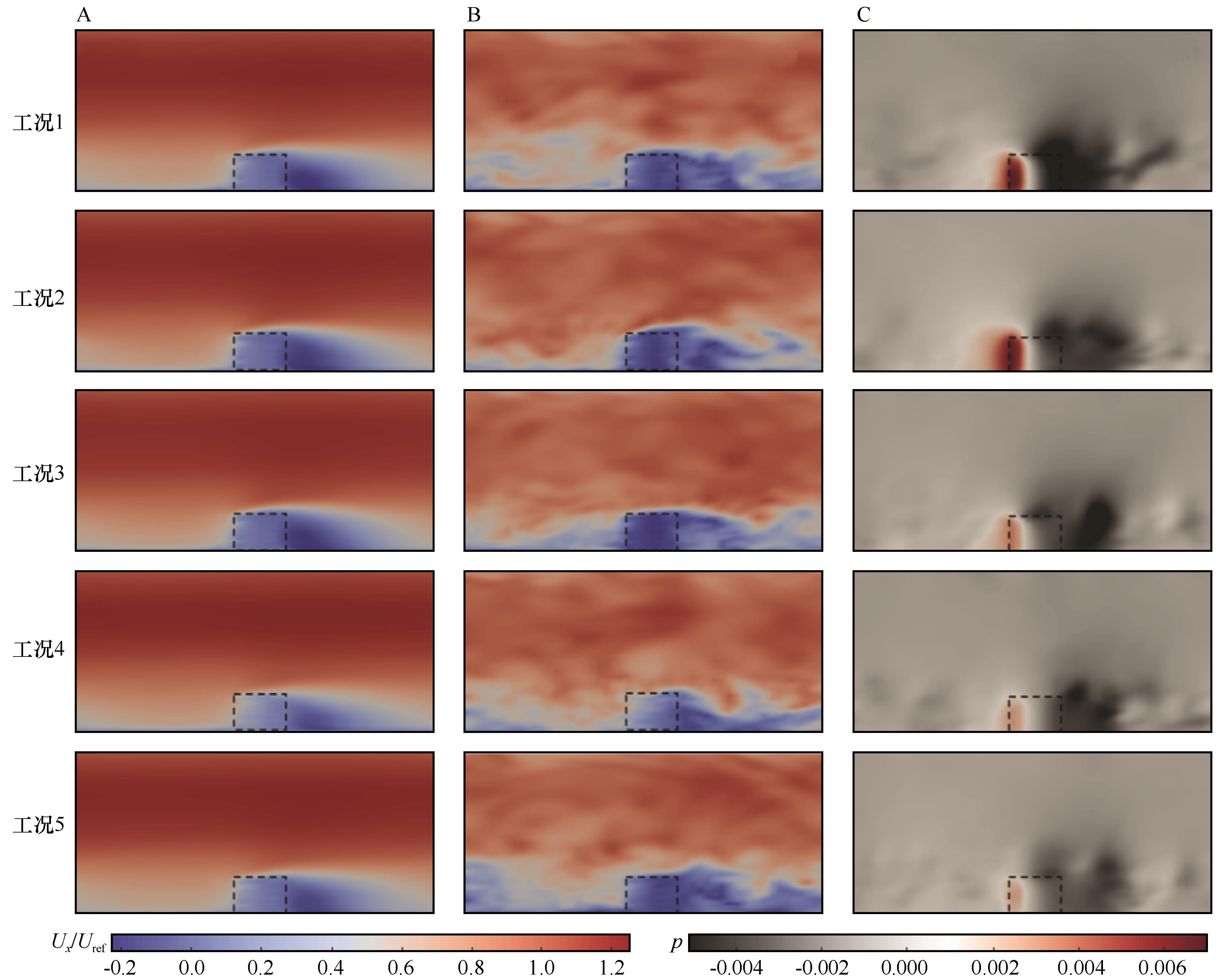
图8 不同植物柔韧性对应的平均速度(A)、瞬态速度(B)与瞬态压力(C)剖面云图
Fig.8 Time-average velocity (A), transient velocity (B), and transient pressure (C) contour plots corresponding to different plant flexibility levels
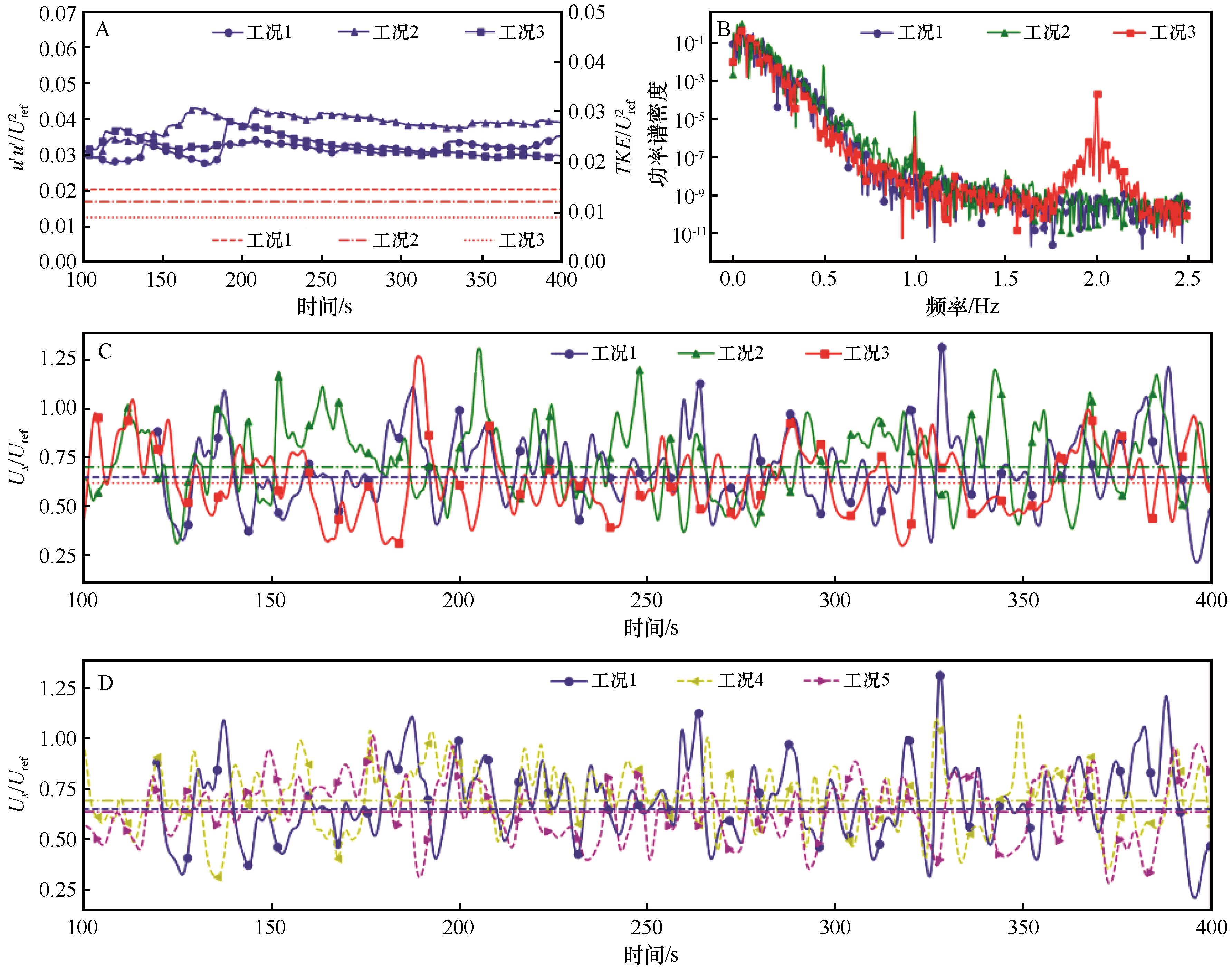
图10 前端接触区的速度脉动与湍动能(A,点线为脉动速度均方,虚线为湍动能TKE)、速度功率谱密度(B)、瞬态速度(C,D,实线为瞬态流向速度,虚线为时间平均流速)
Fig.10 Fluctuating velocity (A, dot solid lines for RMS values and dashed lines for turbulent kinetic energy), spectrogram of velocity energy density (B), transient velocity (C, D, solid lines for instantaneous and dashed lines for time-averaged velocity) in the front contact zone
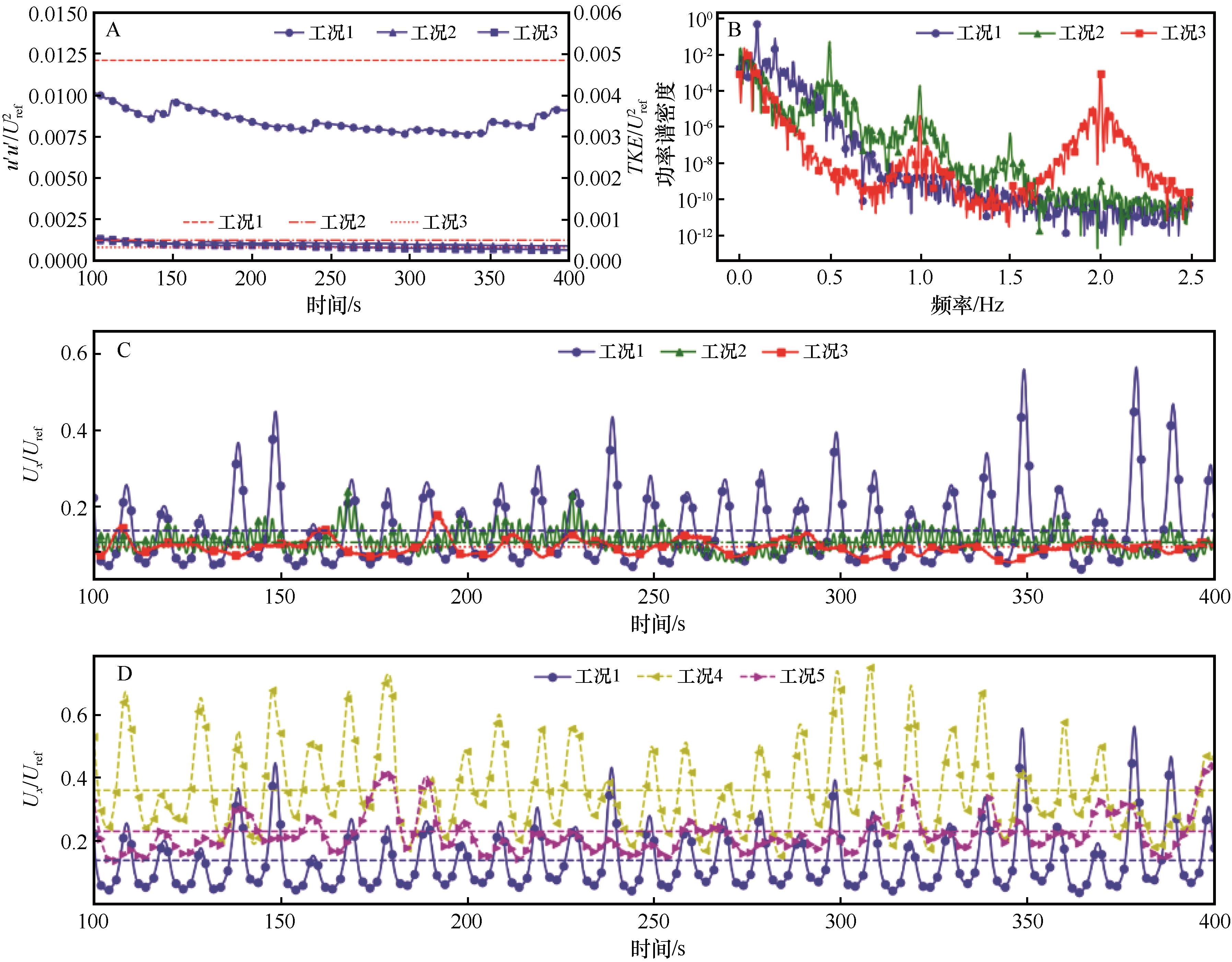
图11 冠层内部脉动速度与湍动能曲线(A)、速度功率谱密度(B)、瞬态流速(C, D)
Fig.11 Fluctuating velocity and turbulent kinetic energy (A), velocity energy density spectrum (B) and transient velocity curves (C, D) inside of canopy
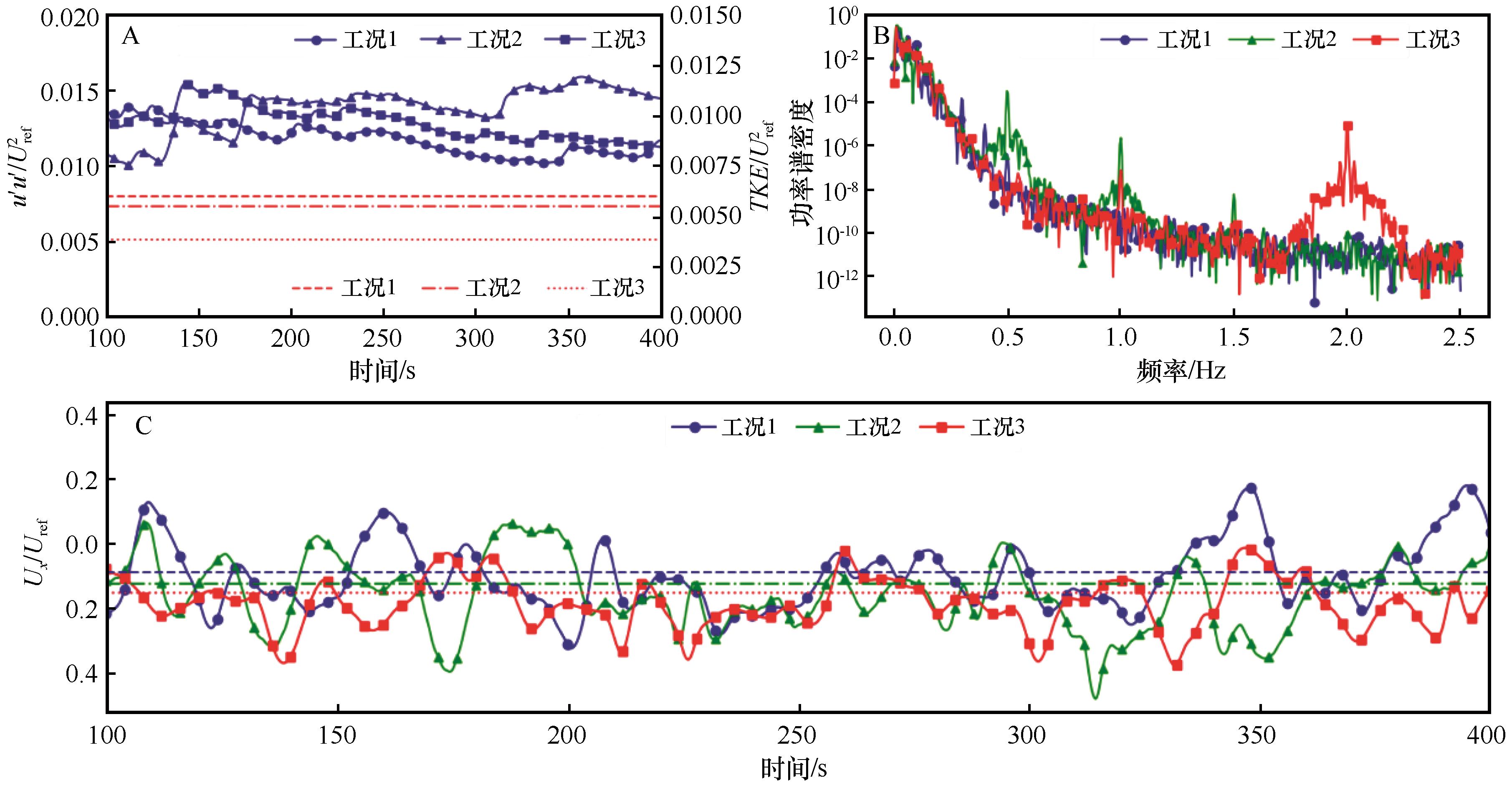
图12 近尾流区脉动速度与湍动能(A)、速度功率谱密度(B)与瞬态流速(C)
Fig.12 Fluctuating velocity, mean turbulent kinetic energy (A), velocity power spectral density (B), and instantaneous flow velocity (C) in near wake region
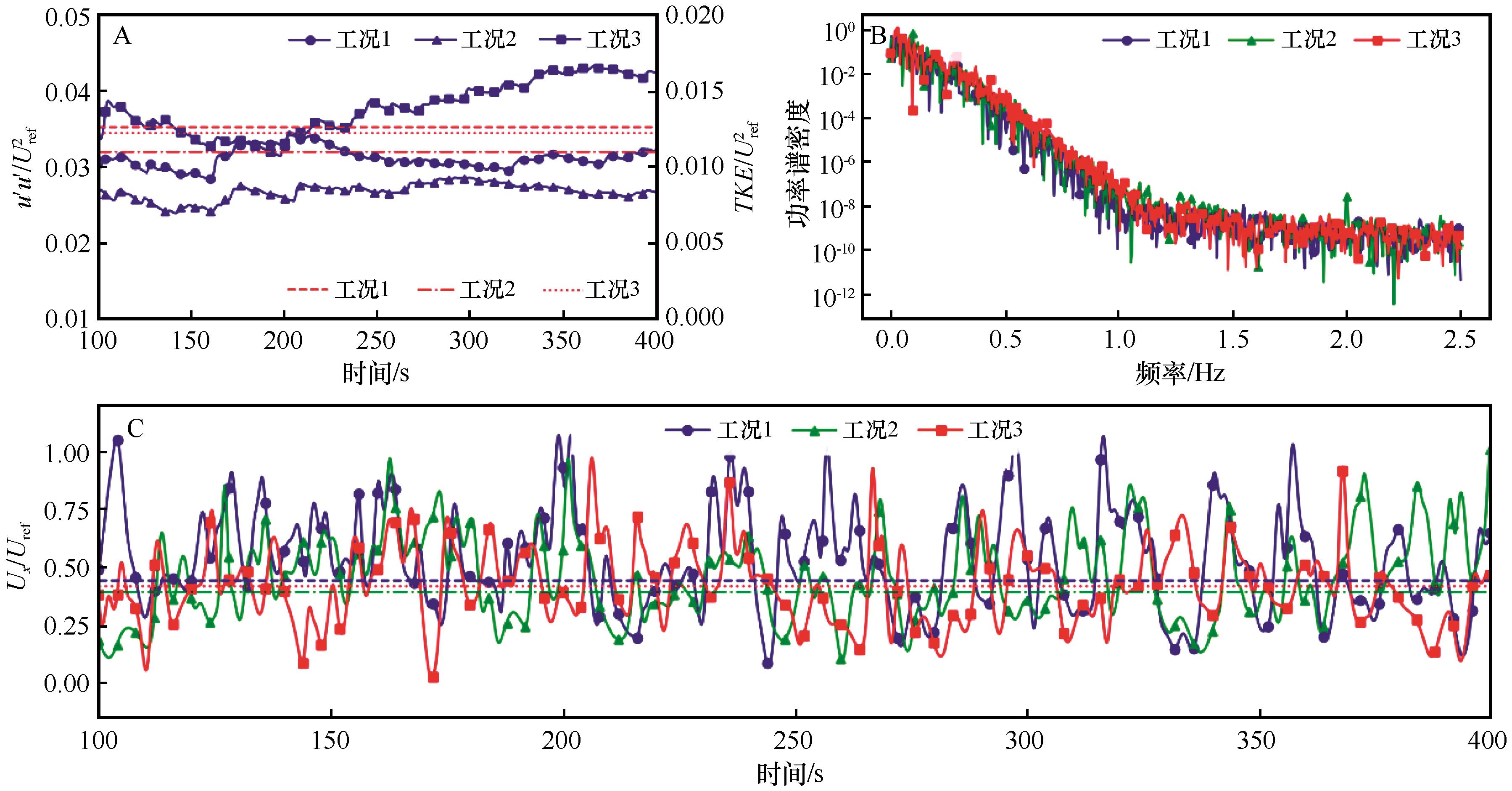
图13 远尾流区脉动速度与湍动能(A)、速度功率谱密度(B)与瞬态流速(C)
Fig.13 Fluctuating velocity, mean turbulent kinetic energy (A), velocity power spectral density (B), and instantaneous flow velocity (C) in far wake region
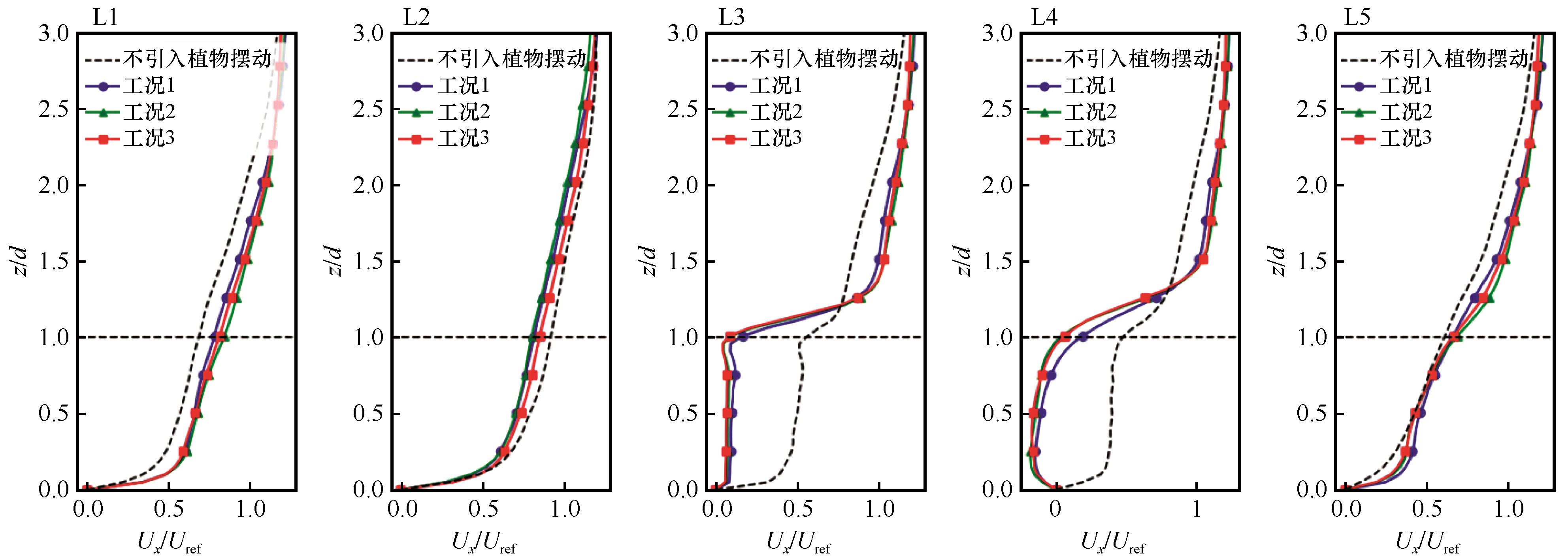
图15 不同柔韧性的植物在不同流向位置处的风廓线,以及刚性孔隙植物模型与柔性植物模型对风廓线计算的差异
Fig.15 Wind profiles at different streamwise locations, and the differences in wind profile between rigid porous plant models and flexible plant models

图16 不同时刻下的柔性植物附近瞬态地表剪切应力分布注:白色的虚线为植物所在的区域,红色虚线为数据监测的位置
Fig.16 The transient distribution of wall shear stress near flexible plants, the white dashed line represents the area occupied by the plants
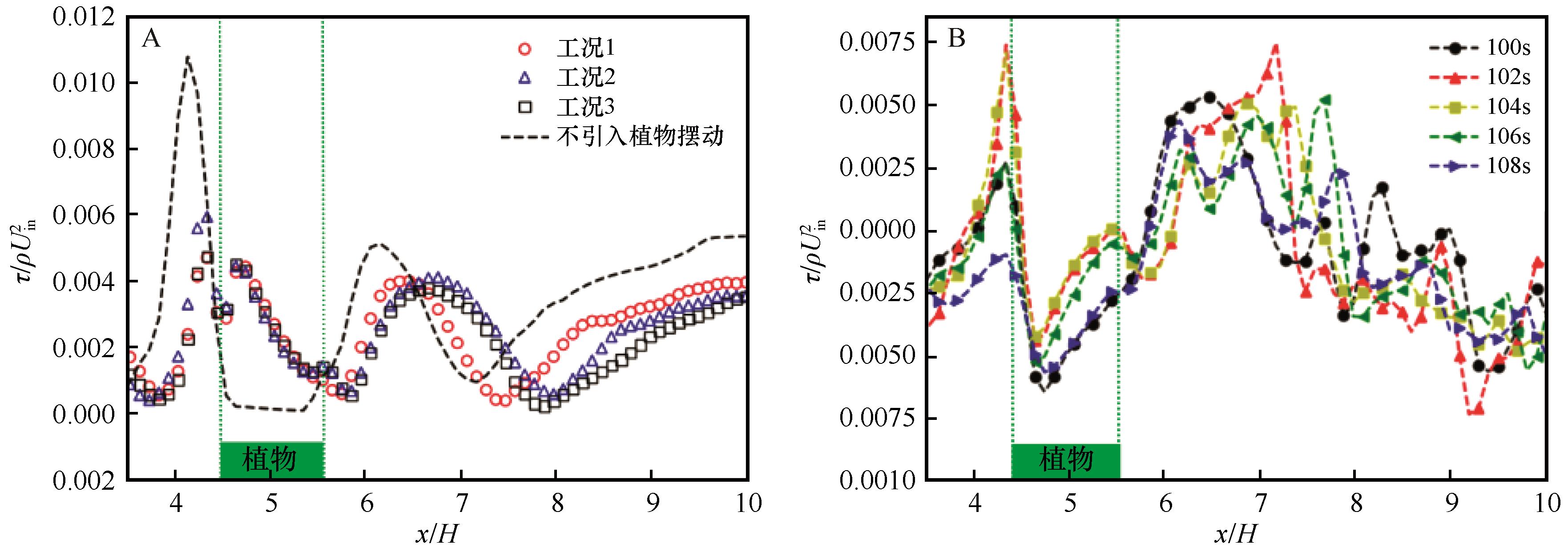
图17 不同工况对应的平均地表剪切应力沿流向距离变化曲线(A),以及不同时刻下中轴线位置处瞬态地表剪切应力沿流向距离变化曲线(B)
Fig.17 Variation of average wall shear stress along the flow direction (A), and variation curves of transient wall shear stress along the flow direction (B)
| 1 | Wolfe S A, Nickling W G.The protective role of sparse vegetation in wind erosion[J].Progress in Physical Geography:Earth and Environment,1993,17(1):50-68. |
| 2 | 屈志强,刘连友,吕艳丽,等.柔韧性概念在沙生植物中的应用[J].中国沙漠,2012,32(1):42-46. |
| 3 | 唐艳,刘连友,屈志强,等.植物阻沙能力研究进展[J].中国沙漠,2011,31(1):43-48. |
| 4 | 张萌,亢力强,王晓美.交错和矩形布置对树状植被地表剪应力和输沙率的影响[J].中国沙漠,2024,44(1):50-60. |
| 5 | 周峰,娄厦, Larisa R D,等.柔性植物影响下水沙运动及物质输运研究进展[J].水利水电科技进展,2023,43(3):107-116. |
| 6 | 金彩平,张景新.波浪流经柔性细杆群衰减规律的数值研究[C]//上海交通大学船舶海洋与建筑工程学院,上海交通大学水动力学教育部重点实验室.第三十三届全国水动力学研讨会论文集.2022:478-485. |
| 7 | 黄本胜,赖冠文,程禹平.海堤外滩地种树效果及对行洪影响[J].人民珠江,1995,88(3):38-42. |
| 8 | 吴福生.含植物明渠水动力特性研究[D].南京:南京水利科学研究院,2009. |
| 9 | Ghisalberti M, Nepf H M.Mixing layers and coherent structures in vegetated aquatic flows[J].Journal Of Geophysical Research:Oceans,2002,107(C2):000871. |
| 10 | Liu R, Zhang J, Yang X,et al.Simulating airflow around flexible vegetative windbreaks[J].Journal Of Geophysical Research:Atmospheres,2021,126(19):034578. |
| 11 | Wu X X, Fan P P.Airflow field and shelter effect around flexible plants using fluid-structure interaction (FSI)-large-eddy-simulation (LES) simulations[J].Journal of Geophysical Research:Biogeosciences,2023,128:007061. |
| 12 | He S, Liu H, Shen L.Simulation-based study of turbulent aquatic canopy flows with flexible stems[J].Journal of Fluid Mechanics,2022,947:A33. |
| 13 | 刘彦东,徐国宾,张雅卓.含柔性沉水植物河道水力特性三维数值模拟研究[J].水资源与水工程学报,2014,25:44-49. |
| 14 | Wilson J D, Finnigan J J, Raupach M R.A First-order closure for diturbed plant-canopy flows,and its application to winds in a canopy on a ridge[J].Quarterly Journal Of The Royal Meteorological Society,1998,124(547):705-732. |
| 15 | Dupont S, Brunet Y.Edge flow and canopy structure:a large-eddy simulation study[J].Boundary-Layer Meteorology,2007,126(1):51-71. |
| 16 | Smagorinsky J.General circulation experiments with the primitive equations:I.the basic experiment[J].Monthly Weather Review,1963,91(3):99-164. |
| 17 | Wood B D, He X, Apte S V.Modeling turbulent flows in porous media[J].Annual Review Of Fluid Mechanics,2020,52(1):171-203. |
| 18 | Chang K, Constantinescu G.Numerical investigation of flow and turbulence structure through and around a circular array of rigid cylinders[J].Journal Of Fluid Mechanics,2015,776:161-199. |
| 19 | 张小霞,林鹏智.波浪作用下柔性草本植物受力特性研究[J].力学学报,2021,53:1018-1027. |
| 20 | Nepf H M.Vegetated flow dynamics[M]//Fagherazzi S,Marani M,Blum L K.Coastal and Estuarine Studies.Washington,DC,USA:American Geophysical Union,2013:137-163. |
| 21 | 苏宇,袁立敏,党晓宏,等.风滚植物高立式沙障防风效应研究[J].内蒙古林业科技,2024,50(3):7-13. |
| 22 | 何志辉,李生宇,王海峰,等.塔克拉玛干沙漠4种结构尼龙阻沙网的防风阻沙效益对比[J].干旱区研究,2014,31(2):369-374. |
| 23 | Belcher S E, Jerram N, Hunt J C R.Adjustment of a turbulent boundary layer to a canopy of roughness elements[J].Journal of Fluid Mechanics,2003,488:369-398. |
| 24 | 亢力强,李彩云,张军杰,等.柔性植株地表瞬时地表剪应力分布特征[J].中国沙漠,2020,40(5):49-56. |
| [1] | 花丛, 刘超, 张碧辉. 影响北京的两次沙尘过程传输特征对比分析[J]. 中国沙漠, 2019, 39(6): 99-107. |
| [2] | 刘超, 花丛, 张恒德, 张碧辉. 基于风廓线雷达的北京春季一次“先霾后沙”空气污染过程分析[J]. 中国沙漠, 2019, 39(5): 88-96. |
| [3] | 温雅婷, 何宏让, 王春明, 王丽琼, 焦冰. 塔克拉玛干沙漠腹地湍流能量耗散率和结构函数参数特征[J]. 中国沙漠, 2014, 34(4): 1094-1101. |
| [4] | 王 柯1,2, 何 清1, 王敏仲1, 胡月宏2, 许文强2. 塔中一次雷暴降水天气过程边界层风场变化特征[J]. 中国沙漠, 2013, 33(3): 896-901. |
| [5] | 王文彪1, 党晓宏2, 张吉树1, 袁立敏2, 王淮亮2, 姜海荣3, 尹晓伟2. 库布齐沙漠北缘不同作物秸秆平铺式沙障的防风效能[J]. 中国沙漠, 2013, 33(1): 65-71. |
| [6] | 王柯, 何清, 王敏仲, 胡月宏, 李晓辉. 塔克拉玛干沙漠腹地边界层风场特征[J]. 中国沙漠, 2012, 32(4): 1029-1034. |
| [7] | 屈志强, 刘连友, 吕艳丽, 唐 艳, 贾振杰. 柔韧性概念在沙生植物中的应用[J]. 中国沙漠, 2012, 32(1): 42-46. |
| [8] | 王敏仲;魏文寿;何 清;王 柯;王 娟;. 边界层风廓线雷达资料在沙尘天气分析中的应用[J]. 中国沙漠, 2011, 31(2): 352-356. |
| [9] | 梅凡民;. 基于湍流结构的风沙颗粒起动动态演化的概念模式[J]. 中国沙漠, 2011, 31(2): 379-385. |
| [10] | 梅凡民;江姗姗;王 涛. 粗糙床面风廓线的转折特征及其物理意义[J]. 中国沙漠, 2010, 30(2): 217-227. |
| 阅读次数 | ||||||
|
全文 |
|
|||||
|
摘要 |
|
|||||
©2018中国沙漠 编辑部
地址: 兰州市天水中路8号 (730000)
电话:0931-8267545
Email:caiedit@lzb.ac.cn;desert@lzb.ac.cn
